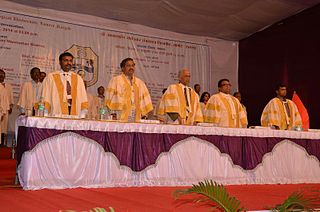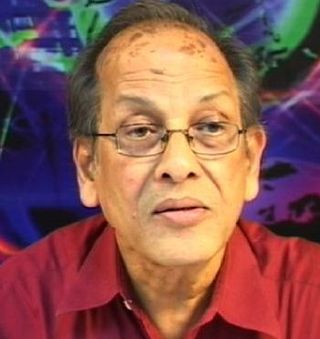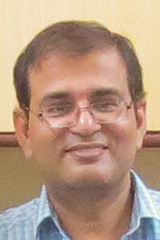
The Indian Institute of Technology Bombay is a public research university and technical institute in Mumbai, Maharashtra.

Man Mohan Sharma, is an Indian chemical engineer. He was educated at Jodhpur, Mumbai, and Cambridge. At age 27, he was appointed Professor of Chemical Engineering in the Institute of Chemical Technology, Mumbai. He later went on to become the Director of UDCT, the first chemical engineering professor to do so from UDCT.
Basalt fibers are produced from basalt rocks by melting them and converting the melt into fibers. Basalts are rocks of igneous origin. The main energy consumption for the preparation of basalt raw materials to produce of fibers is made in natural conditions. Basalt continuous, staple and super-thin fibers are produced and used. Basalt continuous fibers (BCF) are used for the production of reinforcing materials and composite products, fabrics and non-woven materials. Basalt staple fibers - for the production of thermal insulation materials. Basalt superthin fibers (BSTF) - for the production of high quality heat and sound insulating and fireproof materials.
Dr. Ramulu Mamidala is a mechanical engineering professor at University of Washington. Usually goes by the name 'Ram', or 'M.R.', he is recognized for his leadership and outstanding record in promoting collaborative education and research with industry. He is currently the director of Manufacturing Science and Technology Laboratory (MSTL) at Mechanical Engineering Department, University of Washington. He has designed and developed manufacturing methods for a wide range of systems, from the B2 bomber to the Boeing 787. Additionally, in collaboration with industry, he established and directed two interdisciplinary graduate educational programs in engineering and management and a certificate program in composites tooling and manufacturing. His exemplary collaborative efforts motivated working engineers to pursue doctoral studies and he is a leader in using emerging technologies in distance education to reach non-traditional students.

OrthoCAD Network Research Cell is a federally funded research and development facility in the Indian Institute of Technology Bombay, Mumbai, India. The Laboratory's primary function is the design and development of reconstruction systems for orthopaedic and other applications, the current focus is on mega-implants for limb-saving surgery, mainly for children affected by bone cancer. The Cell later led to the establishment of Biomedical Engineering and Technology (incubation) Centre (BETiC).
Three-dimensional composites use fiber preforms constructed from yarns or tows arranged into complex three-dimensional structures. These can be created from a 3D weaving process, a 3D knitting process, a 3D braiding process, or a 3D lay of short fibers. A resin is applied to the 3D preform to create the composite material. Three-dimensional composites are used in highly engineered and highly technical applications in order to achieve complex mechanical properties. Three-dimensional composites are engineered to react to stresses and strains in ways that are not possible with traditional composite materials composed of single direction tows, or 2D woven composites, sandwich composites or stacked laminate materials.

Prof. Narinder Kumar Gupta, known as Prof. N. K. Gupta or Prof Narinder Gupta is a research scientist, educator, and engineer. Born 22 August 1942 in Mirpur, Jammu and Kashmir, India, is Professor of Mechanics at the Indian Institute of Technology in Delhi. Gupta works in the area of large deformations of metals and composites at low, medium and high rates of loading. His research stimulates the development of constitutive behaviour of materials, understanding of the basic mechanics of large deformation, design for crashworthiness of road and air vehicles, design for safety in defence applications and in design of metal forming processes.
V Ramgopal Rao is an Indian academic currently serving as the Group Vice Chancellor of Birla Institute of Technology and Science, Pilani for campuses located in Pilani, Dubai, Goa, Hyderabad and Mumbai. He was previously the Director of IIT, Delhi for six years during 2016-2021.
Chandrathil Gouri Krishnadas Nair is an Indian technocrat, teacher and metallurgical scientist known for his contributions in the field of aeronautical metallurgy. Dr Nair was given the Padma Shri Award by the Government of India for his contributions to science and technology in 2001.

Professor Bhagavatula Dattaguru is an Indian engineer and academic. He has received several awards, including the Padma Shri Award, India's fourth highest civilian honour in 2005 in the field of science and engineering.

Tarun Kant, an institute chair professor at the Indian Institute of Technology Bombay in Mumbai since December 2009, was born on 1 July 1946 in Ballia, Uttar Pradesh, India. He received a BSc degree from Allahabad University in 1962, a B.Tech (Hons.) degree in civil engineering from IIT Bombay in 1967 and an M.Tech in civil engineering, specializing in structural engineering, from the Indian Institute of Technology Kanpur in 1969. Kant spent about 18 months at a consulting engineering firm in Mumbai before becoming a lecturer at IIT Bombay in January 1971. He received a PhD degree in 1977. Kant became an assistant professor in 1978 and a professor in 1986. At IIT Bombay, he has been a department head (2000–2002), dean of planning (2001–2003) and chair of the Joint Entrance Examination (1998) and the Central Library (1995–1999).

Bhrigu Nath Singh, also known as B.N. Singh, is an Indian engineering scientist and the director general at the IITRAM. He is a distinguished professor, former HAL chair professor and Institute's first Dean of Human Resources(2016-2020), Indian Institute of Technology Kharagpur. Chair of the ICTACEM and former Head of Department Aerospace Engineering, IIT Kharagpur.

Wiesław Kazimierz Binienda is a Polish-American scientist, researcher, PhD, and professor and co-director of the Gas and Turbine Research and Testing Laboratory on the Department of Civil Engineering at the University of Akron.
Sandeep Verma is an Indian bioorganic chemist and chemical biologist, and a Professor in the Department of Chemistry at the Indian Institute of Technology, Kanpur (IITK). At IITK, he heads Sandeep Verma's Research Group in the areas of ordered peptide assemblies, metal-mediated nanoscale systems, programmable soft matter for neuronal regeneration, novel antimicrobials, and small molecule-stem cell modulation. He is an elected fellow of the Indian National Science Academy (INSA), the Indian Academy of Sciences, the National Academy of Sciences, India, and the Indian National Academy of Engineering. The Council of Scientific and Industrial Research, the apex agency of the Government of India for scientific research, awarded him the Shanti Swarup Bhatnagar Prize for Science and Technology, one of the highest Indian science awards, in 2010, for his contributions to Chemical Sciences.
Devang Vipin Khakhar is an Indian chemical engineer and the former director of the Indian Institute of Technology Bombay. He is known for his pioneering researches on polymerization and is an elected fellow of all the three major Indian science academies viz. Indian Academy of Sciences, Indian National Science Academy and National Academy of Sciences, India as well as Indian National Academy of Engineering. The Council of Scientific and Industrial Research, the apex agency of the Government of India for scientific research, awarded him the Shanti Swarup Bhatnagar Prize for Science and Technology, one of the highest Indian science awards for his contributions to Engineering Sciences in 1997.

Subhasis Chaudhuri is an Indian electrical engineer and former director at the Indian Institute of Technology, Bombay. He is a former K. N. Bajaj Chair Professor of the Department of Electrical Engineering of IIT Bombay. He is known for his pioneering studies on computer vision and is an elected fellow of all the three major Indian science academies viz. the National Academy of Sciences, India, Indian Academy of Sciences, and Indian National Science Academy. He is also a fellow of Institute of Electrical and Electronics Engineers, and the Indian National Academy of Engineering. The Council of Scientific and Industrial Research, the apex agency of the Government of India for scientific research, awarded him the Shanti Swarup Bhatnagar Prize for Science and Technology, one of the highest Indian science awards, in 2004 for his contributions to Engineering Sciences.

Yogesh Moreshwar Joshi is an Indian chemical engineer, rheologist and the Pandit Girish & Sushma Rani Pathak Chair Professor at the Indian Institute of Technology, Kanpur. He is known for his studies on metastable soft matter and is an elected fellow of the Society of Rheology, Indian National Science Academy, Indian Academy of Sciences, and Indian National Academy of Engineering. In 2015, the Council of Scientific and Industrial Research, the apex agency of the Government of India for scientific research, awarded Joshi the Shanti Swarup Bhatnagar Prize for Science and Technology for his contributions to Engineering Sciences. In 2023, he received prestigious J C Bose fellowship constituted by the Science and Engineering Research Board, Government of India.
Amitabha Ghosh is an Indian researcher, administrator and educator. He currently holds the position of Honorary Scientist, Indian National Science Academy and Honorary Distinguished Professor in the Aerospace Engineering and Applied Mechanics Department at the Indian Institute of Engineering Science and Technology, Shibpur, Howrah, West Bengal. He is an Emeritus Senior Fellow of the Alexander von Humboldt Foundation and a Fellow of The National Academy of Sciences, India, of which he was elected a Senior Scientist Platinum Jubilee Fellow in 2012. Ghosh has made contributions in various fields, including fundamental and applied research, technology development, administration and social development.

3D textiles are three-dimensional structures made with different manufacturing methods such as weaving, knitting, braiding, or nonwoven, or made with alternative technologies. 3D textiles are produced with three planar geometry, opposed to 2D textiles that are made on two planes. The weave in 2D textiles is perpendicular. The yarn is fed along two axis: length (x-axis) and width (y-axis), while 3D textiles also have a perpendicular weave, but they have an extra yarn with an angular feeding (z-axis) which creates thickness. 3D weaves are orthogonal weave structures, multilayer structures, and angle interlocks. 3D textiles have more manufacturing opportunities, various properties, and a broader scope of applications. These textiles have a wide range of applications, but they are most commonly used where performance is the primary criterion, such as technical textiles. Composite materials, manufacturing is one of the significant areas of using 3D textiles.
Maciej S. Kumosa is a materials scientist and academic. He is a professor in the Department of Mechanical and Materials Engineering at the University of Denver, and the Director of the Center for Novel High Voltage/Temperature Materials and Structures (HVT).













